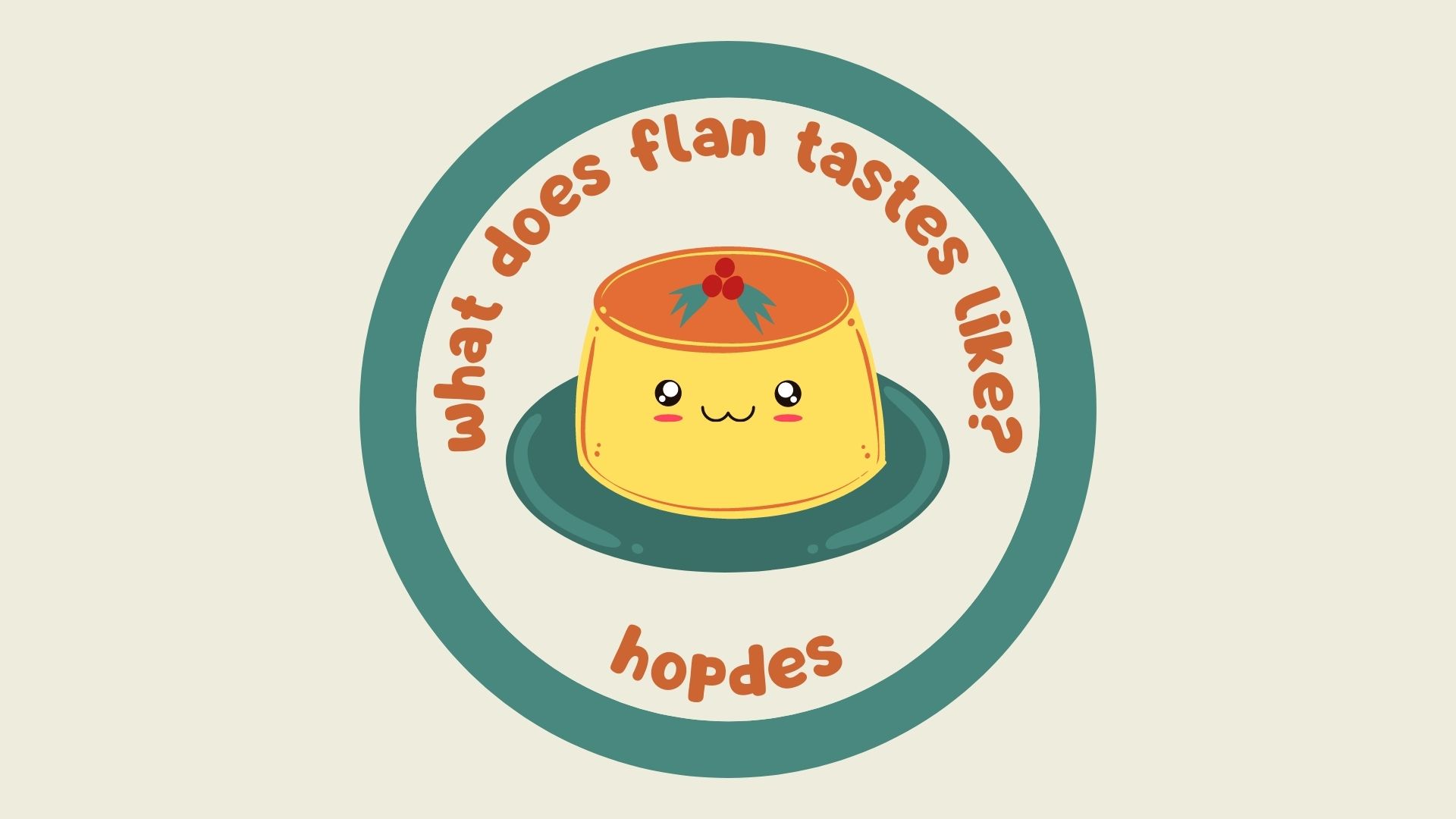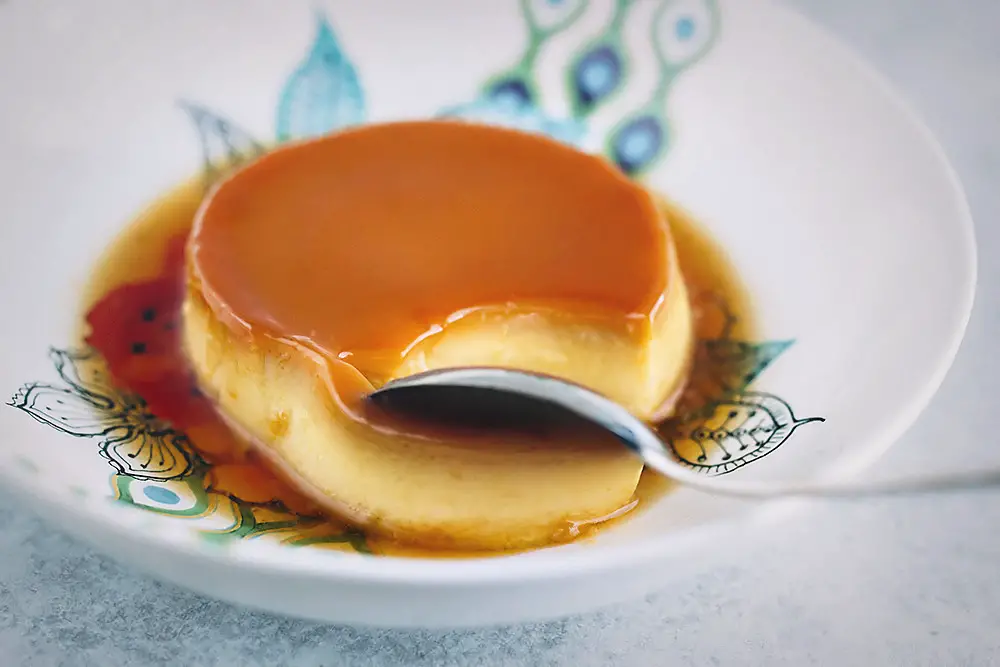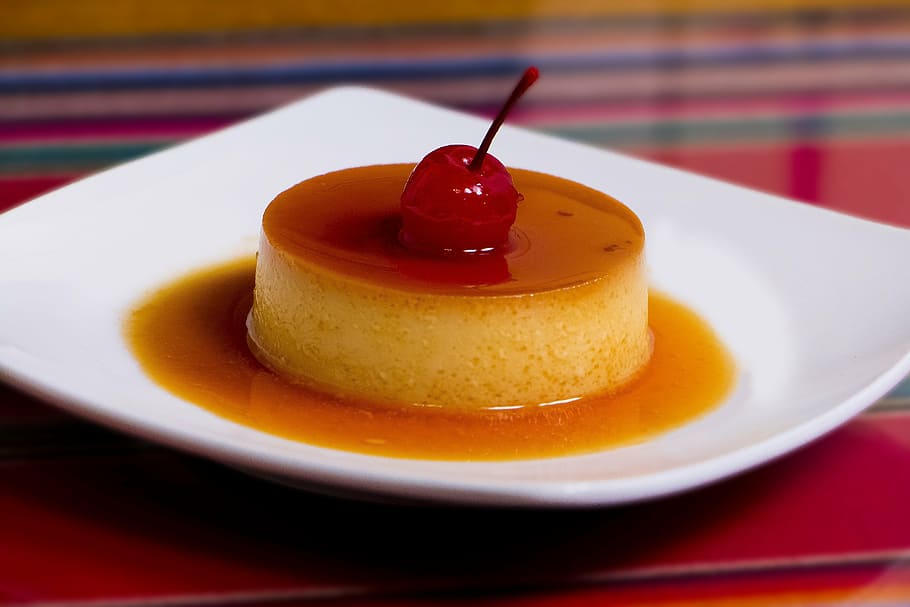
If you’re in search of a dessert that’s simple to prepare, adaptable, and incredibly satisfying, look no further than flan. Flan is a dessert based on custard baked in a water bath and adorned with a luscious caramel sauce. Its texture is velvety smooth and contrasts beautifully with the crispy, sticky caramel topping.
Flan offers the flexibility of being flavored with a variety of ingredients. Beyond its deliciousness, flan boasts a rich and diverse history that spans ancient times and continents. Today, we’ll explore what flan tastes like, its flavor, the factors shaping it, and its variations, which offers a comprehensive look into this delightful dessert.
What Does Flan Taste Like?
Flan tastes like a creamy and smooth dessert with a rich caramelized flavor. The combination of the custard’s creamy texture and the caramel’s smoothness results in a dessert that practically melts in your mouth. This sensation is both satisfying and indulgent, making each bite a true delight.

This unique taste can be attributed to the inclusion of various dairy elements like cream cheese, sweetened condensed milk, and evaporated milk.
The top layer showcases a luxurious blend of rich sweetness with a subtle smokiness. On the other hand, the bottom part presents a creamy, milky, and delicately eggy flavor, all harmoniously balanced in terms of sweetness. Let’s understand the flavor on a deeper level!
Texture
Flan offers a smooth and creamy feel that easily melts in your mouth. It’s created by cooking eggs and milk in water until they become a custard base. This custard is then topped with caramel sauce, which gives the flan a sticky and gooey feel.
In the event that you notice excessive wobbling, it’s a sign that a bit more cooking time is required. Conversely, if the custard turns too thick, it might have been cooked for too long, resulting in a dry feel.
Flavor
The cake’s flavor strikes a balance between the deep richness of the caramel and the airy quality of the creamy filling. The caramel brings a sweet and toasty taste that wonderfully matches the creamy filling.

Flan comes in various flavors based on the ingredients and added flavors. The most usual flavor is vanilla, giving flan a gentle and sweet taste. Nonetheless, flan can offer different tastes like chocolate, or coconut.
Aroma
Flan carries a delightful and welcoming scent arising from the caramel sauce and the added flavorings. The caramel sauce exudes a buttery and nutty fragrance that entices you to indulge. Additional flavorings like coffee or fruit contribute their own unique scents to the flan, making it even more enticing and mouthwatering.
Similar to Panna Cotta
Flan and Panna Cotta may appear quite alike, but their flavors diverge. The key contrast lies in the ingredients that grant them their rich and creamy texture. Panna Cotta gets its thickness from gelatin, while flan relies on eggs. This distinction results in a slight difference in their tastes.
Taste like Creamy Caramel
Flan first appeared in Roman cooking and closely resembles the French dessert known as creme caramel. However, they have slight differences in ingredients and how they’re cooked. While they share the same taste, their textures are not quite the same.
Resembling Creme Brulee
Creme brulee and flan are both custardy treats, yet they don’t have identical flavors. Creme brulee boasts a more intense and solid texture, whereas flan presents a smoother and silkier feel. Further, creme brulee carries the essence of vanilla, whereas flan can offer different flavors like cheese or coconut.
Suggested Reading: What Does Asparagus Taste Like?
What Influences the Taste of Flan?
We’ve compiled a list of key aspects that influence the taste of flan. When preparing flan, it’s essential to keep these factors in mind to enhance its overall taste.

Sugar Choice and Amount
The kind of sugar you use for the caramel sauce can change how flan tastes and looks. For instance, white sugar makes a lighter, sweeter caramel. But if you go for brown or raw sugar, the caramel gets darker and richer, with a little molasses touch.
Also, the amount of sugar you use in the caramel sauce changes how sweet and bitter the flan becomes. Too much sugar makes the caramel super sweet and kind of heavy, while too little sugar makes the sauce thin and not so flavorful. To find the right balance, around 1/4 cup of sugar for each cup of milk works well. This way, you’ll create a flan with a taste that’s just right – not too sweet and not too mild.
Egg Freshness
The freshness of eggs has a secret power in changing how flan feels and tastes. When eggs are fresh, their whites and yolks are strong and firm. This magic makes the flan smooth and set up perfectly. Also, fresh eggs have a gentle flavor that lets other yummy things shine.
But, if the eggs are older, their whites and yolks might be watery and not so good. This can make the flan feel not so smooth and a bit gritty. Plus, old eggs might have a strong smell and taste that’s not so good for the flan’s sweet taste.
Milk Type and Quantity
The kind and amount of milk can also play a tasty game. Each milk type has its own fat amount that changes how the flan looks and feels in your mouth.
Think of whole milk as the creamy champ with more fat, while skim milk is the light one. Evaporated milk is like a magic trick, having less water and making the flan denser. And condensed milk is sweet like a dessert superhero.
A common mix is 4 eggs and 2 cups of milk, but you can mix it up as you like. It’s like your cooking adventure, so you decide how creamy, sweet, or rich your flan gets.
Temperature and Time
Cooking time and temperature are like the chefs creating the taste of flan. If you get them just right, you’ll have a custard that’s smooth and lovely, making your mouth happy. But be cautious – overcooking can result in the flan becoming rubbery and less enjoyable in texture.
To know if your custard is ready, try the knife or toothpick trick. If they come out clean, you’re a winner. The optimal temperature is around 180°F (82°C). That’s your signal that your flan is ready to eat.
Mold Type
The selection of mold or ramekin isn’t just about appearance – it’s a flavorful decision that influences how your flan tastes. The size of the mold governs the amount of custard and caramel in each portion. It also has a say in cooking time and temperature.
Smaller molds cook faster and more evenly than larger ones. Moreover, the size sets the stage for custard-caramel harmony. In smaller molds, caramel can dominate each bite. Further, some shapes make the custard thicker or thinner, giving it a different texture.
Resting Time
Resting time is the gap between baking and refrigerating or serving the flan. During this phase, the flan cools down gently and continues a slight cooking process from its retained heat.
This dance of patience rewards the custard with increased firmness, silkiness, and a richer aroma. The magic of resting also shields the flan from cracks or collapses during unmolding, as it gets a chance to pull away from the mold’s edges.
The duration of the flan’s resting time varies with mold type, personal style, and size. However, two vital steps are key: a 30-minute cooldown at room temperature followed by at least 6 hours in the fridge. While some recipes extend the rest to an hour or more, it’s wise to avoid overdoing it.
Related: What Do Snails Taste Like? Do They Taste Good or Bad?
Flan Varieties Differ in Their Flavor Profiles
Flan is a versatile dessert, which offers an array of flavors in its various forms. These different flavors come from the ingredients used. Let’s explore these varieties:
- Coconut Flan – One of the well-loved variations is coconut flan. Instead of regular milk, it uses coconut milk. This adds a tropical touch, making it sweet and nutty.
- Coffee Flan – Coffee flan is also popular. It includes coffee or espresso as the main ingredients. This gives it a rich and inviting taste.
- Chocolate Flan – Another option is chocolate flan. It’s getting more popular. This one has cocoa powder or melted chocolate added to the mix, making it rich and chocolatey.
- Savory Flan – Lastly, there’s savory flan, which is not as known. It includes ingredients like cheese, spinach, or mushrooms. This makes it savory and can be enjoyed as an appetizer or side dish.

Suggested Reading: 5 Reasons to Put Ice Cube on Burger While Grilling
Tips to Enjoy Flan
If you’re new to flan, you might be curious about the best ways to relish it. Enjoying flan can be tailored to your preferences, and here are a few suggestions:
- Chilled Indulgence: Flan is a delightful treat when served cold. It’s especially wonderful during hot summer days, offering a cool and refreshing dessert option.
- Fruitful Enhancement: Improve the taste of flan by adding fresh fruits like berries or sliced bananas. This infusion of fruit introduces a delightful contrast to the sweet notes of custard and caramel.
- Creamy Complement: Pairing flan with whipped cream is a match made in dessert heaven. The addition of whipped cream brings an extra layer of velvety richness to the dessert.
- Explore Varieties: Don’t hesitate to explore different flan variations. From chocolate flan to coconut flan, and even savory flan, there’s a world of flavors to discover and savor. Each variation offers a unique and enjoyable twist on the classic. For example, many flan recipes incorporate vanilla extract or other flavorings to enhance the overall taste. Vanilla complements the sweetness and adds a subtle aromatic note that enhances the overall experience.
Conclusion
Flan offers a symphony of flavors and textures that dance on the palate. Its velvety custard, kissed by sweet caramel, creates a harmonious balance that’s simply irresistible. A delicate hint of vanilla and subtle eggy notes add intrigue, while the contrasting caramelized layer adds depth. This dessert, like a sweet sonata, melts in your mouth, leaving a silky sensation that lingers. Don’t miss out on this “flantastic” experience – it’s a dessert that truly takes the cake!
What Does Flan Taste Like? - FAQs
Flan is a popular dessert with Latin roots. It’s a smooth, creamy custard dessert that’s typically topped with a layer of caramelized sugar. It has a delicate texture and a rich flavor profile.
Yes, the classic preparation of flan involves pouring caramelized sugar into the mold before adding the custard mixture. After baking and chilling, the flan is inverted onto a plate, allowing the caramel to drizzle over the top.
While vanilla is a common flavoring, variations can include citrus zests, almond extract, or even coffee. The caramel layer, however, remains a constant, adding its unique bittersweet essence.
Yes, traditional flan is typically gluten-free since it’s made with ingredients like eggs, milk, sugar, and flavorings.
 Reviewed by
Reviewed by ![What To Wear To a Drag Show? [HOTTEST Outfit Ideas]](https://hopdes.com/wp-content/uploads/2024/01/What-to-wear-to-a-Drag-Show-390x220.jpg)



![What to Wear to an Outdoor Concert? [Cute Outfit Ideas]](https://hopdes.com/wp-content/uploads/2023/11/What-to-Wear-to-an-Outdoor-Concert-Cute-Outfit-Ideas-390x220.jpg)
